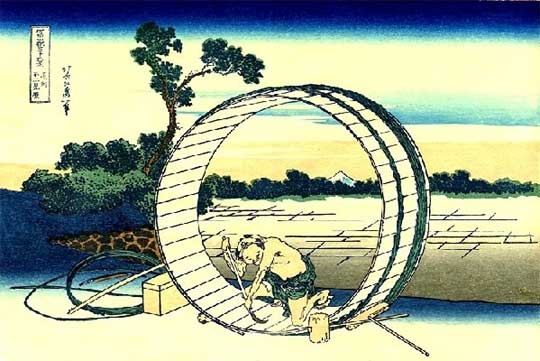|
GREAT SEARCH
MY OTHER SITES
This is a very small web directory for DXers. You may search and suggest favorite homepages there.
This is my verifications gallery contains 315 items which were sent from broadcasting stations in 1970s and 80s.
This web site is dedicated the USA county hunters in Japan. Although all the contents are writen in Japanese, they can be translated to English automatically.
MY FAVORITES
This is the multiple and selectable DX-cluster which is managed by Motoo, JA4PXC. You can customize its windows as you like.
|
Top page >
Japan A-Z >
Traditional Culture of Japan
TRADITIONAL CULTURE OF JAPAN
I want to introduce some traditional culture which emits the origin to Japan on this page.I am very glad supposing you can get interested in old Japanese culture.
"Bonsai"
Bonsai is a horticultural art whereby trees and grasses are transplanted into small containers and are trained to grow into the shapes of naturally grown trees or grasses in the earth. Evergreen trees such as pine or cedar are highly preffered for bonsai, but deciduous trees like maple, or fruit trees like plums are also used. The average height of a tree is approximately 50cm.
"Haiku"
Haiku, a Japanese poetic form, developed from the longer haikai, the first part of which became an independent unit. It comprises 17 syllables (5-7-5 syllables) and has to contain kigo, a word that expresses a season. Matsuo Basho was a famous haiku poet in the Edo period (1600-1868). In the Meiji period (1868-1912), Masaoka Shiki revolutionized haiku.
Let's make English Haiku. First, pick a "season" in nature and describe it through any of the five senses. Depict the moment as it is in three lines, forming a short poem.
Matsuo Basho: "Old pond / A frog jumps in / Water's sound"
"Ikebana"-Flower arrangement
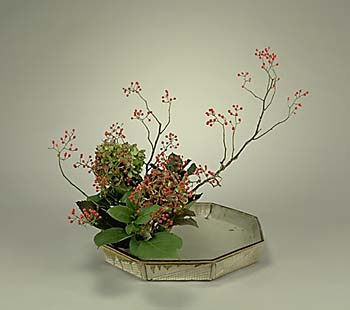 Ikebana is the art of traditional Japanese flower arrangement, originally related to religious ceremonies. Flowers were originally arranged where gods were welcomed or used as offerings at Buddhist altars. When the tea ceremony became popular in the 16th century, flowers were arranged in tea ceremony rooms.
Ikebana is the art of traditional Japanese flower arrangement, originally related to religious ceremonies. Flowers were originally arranged where gods were welcomed or used as offerings at Buddhist altars. When the tea ceremony became popular in the 16th century, flowers were arranged in tea ceremony rooms.
"Kabuki" and "No"
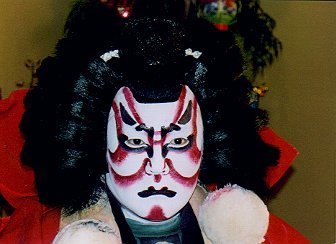 Kabuki originated in the early Edo period, when a woman called Okuni of Izumo performed a Buddhist dance in an usual costume in Kyoto. The dance was later deemed morally unaxxeptable, and women were prohibited from performing it.Instead, only adult men were allowed to perform. This costom has been maintained in present-day kabuki.
Kabuki originated in the early Edo period, when a woman called Okuni of Izumo performed a Buddhist dance in an usual costume in Kyoto. The dance was later deemed morally unaxxeptable, and women were prohibited from performing it.Instead, only adult men were allowed to perform. This costom has been maintained in present-day kabuki.
No originated in the art of dengaku (ritual field music and dance) and sarugaku (music play) in the Kamakura era; which developed as music-plays incorporating beautiful music and danses in the Muromachi era. Kan'ami and Zeami, farther and son, sompleted no, fashioning it into as a performing art.
"Kendo"-Japanese Fencing
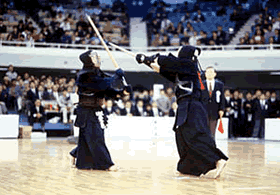 Begin with a bow, end with a bow." This polite custom reflects the spirit of kendo. Using a bamboo sword instead od steel one, kendo came from kenjutsu (old-style kendo), a kind of fencing only for samurai. Even now there are many kendo fans of the gallant samurai ideal.
Begin with a bow, end with a bow." This polite custom reflects the spirit of kendo. Using a bamboo sword instead od steel one, kendo came from kenjutsu (old-style kendo), a kind of fencing only for samurai. Even now there are many kendo fans of the gallant samurai ideal.
"Sumo"
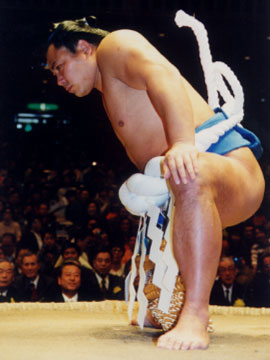 Sumo the national sport of Japan.It is a match of two sumo wrestlers who wear only belly belts in the ring. Originally, sumo was used to measure the wrestlers' strength or for dueling, but it is now a professional spectator sport.
Sumo the national sport of Japan.It is a match of two sumo wrestlers who wear only belly belts in the ring. Originally, sumo was used to measure the wrestlers' strength or for dueling, but it is now a professional spectator sport.
Nihon Sumo Kyokai (the Japan Sumo Association) holds six tournaments a year. The competition is conducted in accordance with traditional rituals such as a ring-entrance ceremonies by wrestlers in the makuuchi and yokozuna (grand champion) divisions, and a bow-twirling rite.
The winner is decided when the opponent is forced out of the ring or when any part of his body including the topnot touches the ground. It is said that there are 48 winning techniques, but the Japan Sumo Association has classified up to 70.
"Ukiyoe"
A genre painting popular among the common people during the Edo period (1600-1868). Ukiyoe means "pleasure-seeking," or "sensual" in Japanese, and this world was actually the subject of paintings called "ukiyoe". Most ukiyoe were prints that could be mass-producted. Drawings are rare.
|
![[THE 7N2UTO's HOMEPAGE]](../images/7N2UTO.jpg)
![[THE 7N2UTO's HOMEPAGE]](../images/7N2UTO.jpg)
